#Gao Qipei (1660-1734)
Photo

Gao Qipei (Chinese, 1660–1734), Tiger, n.d.
5 notes
·
View notes
Photo
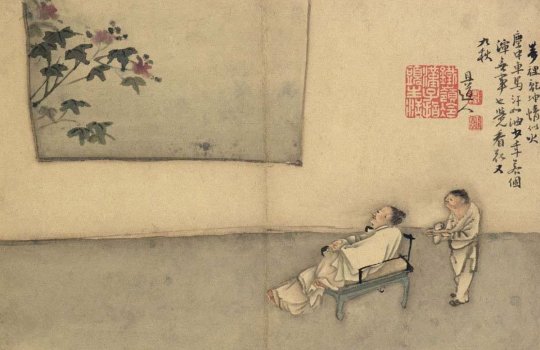
GAO QIPEI (1660-1734)
Figures
Each leaf inscribed and/or signed, with a total of seventeen seals of the artist
Colophon by Ye Gongchuo (1881-1968), signed with one seal, dated yichou year (1925)
Titleslip by Ye Gongchuo with one seal
Handwritten note by Chen Rentao (1906-1968)
Album of ten leaves, ink and colour on paper
Each leaf measures 26 x 32 cm. (10 1/4 x 12 5/8 in.)
interesting notes found in chinese and translated by google, and they may be wrong but they are amazing:
Gao Qipei was born in the 17th year of Shunzhi in Qing Dynasty (1660) and died in the 12th year of Yongzheng (1734). He made one (1672-1734) at the age of 75. The word Wei Zhi, also called Wei San, was called Qieyuan, or Shuqi Taoist, and was also called Nancun, from Tieling (now in Liaoning). Gong Poetry. When he was young, he studied traditional painting. Landscapes and figures were influenced by Wu Wei. After his middle age, he began to paint with his fingers. His paintings of flowers, trees, birds and beasts, fish, dragons and figures are all simple and vivid. Interesting.
He is also the author of "Qieyuan Poems".
According to "Tieling County Chronicles", he was a descendant of a famous eunuch, and was the fifth son of Gao Tianjue, Qingqi captain of Qingqi inlaid with a white banner in the Qing Han army. Gao Qipei studied painting at the age of eight. He traveled to Guangdong with his uncle Gao Chengjue. At that time, there was Wu Wei in the official office of Guangdong, who was able to paint with fingers, and Gao Qipei was deeply influenced by him. He lost his father at the age of seventeen and was raised by his uncle Gao Chengjue. He did not apply for the imperial examination. Zu Yin served as Yaozhou Mu in the 33rd year of Kangxi (1694) and was transferred to Yu Bulang the following year. Forty years in Kangxi (1701), he was governed by the prefects of Suzhou, and two years later, he moved inward as a member of the Ministry of Engineering, Wailang. In the forty-five year of Kangxi (1706), he was sent out to visit Wenchu Road in Zhejiang Province. Later, he was lost to the salt department because of a debt to the salt department while he was serving as a young transport agent. In the fifty-fourth year of Kangxi (1715), Gao Qipei stepped into his official career and served as the Sichuan branch patrol on the South Shuining Road in Sichuan for six years. He was promoted to the governor of Sichuan and served in Chengdu in the fifty-ninth year of Kangxi (1720). . In the first year of the Yongzheng period (1723), he moved to Guanglu, the minister, and was promoted to the right minister of the penalty department in September. In the second year, the red flag was promoted to the capital of the Han army, and still led the rank of the right servant of the criminal ministry. In July of the fifth year of the Yongzheng period (1727), he was dismissed from office due to a mistake in his appointment as the Secretary-in-Chief of the Criminal Department. Although he lived in another country for a long time and wandered around the ocean, he did not forget his hometown. His paintings often included: "Tieling Gao Qipei Finger Painting", "Tieling Gao Qilang", "Tieling Ancient Madness", so people had "Gao Tieling" for him. "The name.
In Gao Qipei's later years, the reputation of finger painting spread far to North Korea, but he still painted "cannibalism to suck blood and frequent candlesticks during the day." In the eighth year of Yongzheng (1730), Yingzhao Yuanmingyuan Ruyi Museum was painting for 3 years, and he created fine silk meticulous paintings such as "The Map of the Yangtze River". Gao Bing's "Finger Painting Theory" records that Gao Qipei was once a portrait of Lu Shuntu, the Shangshu of the Ministry of War, and he drew a standing statue, which is in line with the real person. After the painting was completed, Lu Shuntu said ecstatically : "It's so skillful”
118 notes
·
View notes
Photo
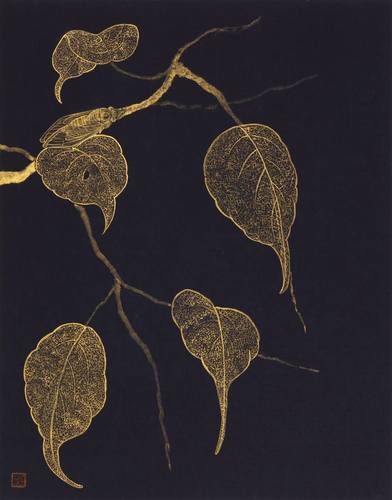
Prayer of A Cicada, HyunJung Kim
Drawing: goldpowder and realgold on Paper. Heaviness wrapped up with Lightness – Reading Kim HyunJung’s painting Lee DongChun (Fine art Connoisseur) Kim HyunJung’s paintings are cute and interesting. Her painting reminds us of paintings by Qi Baishi 齐白石 (1864-1957). Qi Baishi pursued beauty in his life, and his artistic spirit is found in his plant-and-insect paintings, flower-and-bird paintings, and figure paintings. Qi Baishi’s artistic spirit is sensed in Kim’s interesting subject matter and candid depiction.Kim audaciously uses ink and bright hues in in the manner of Qi Baishi who applied ink to leaves and red to flowers 墨叶红花. The composition in which subject matter is drawn to the edge of the paper is parallel to that of Qi Baishi’s flower-and-bird paintings and landscape painting of Li Keran’s 李可染 (1907-1989). Kim obviously learned from Qi Baishi. Qi Baishi said, “Learn from me you stand, copy from me you fall 学我者生, 似我者死.” Kim modeled herself after Qi’s artistic spirit rather than his painting style. Kim explored the artistic spirit in Qi Baishi’s painting, in which he emphasizes the meaning of painting and expresses his spirit, and reconstructed this in a realistic rendition. She calls this the “chulsa-ipgong 出写入工” technique. This is a melding of “xieyi 写意” painting (painting that underlines the painter’s spirit), “gongbi-hwa 工笔画” (painting done very carefully with the utmost care for details), and a new invention in tune with her emotion. Zheng Xie 郑燮 (1693-1765), one of the Eight Eccentrics of Yangzhou during the Qing Dynasty asserted, “Learn half, and throw away half 学一半, 撇一半.” This means even if a tradition is excellent, you have to learn only half of it. However, the traditional is currently completely disregarded. Kim learned her ‘half’ from traditional Eastern techniques. She studied the idioms of flower-and-bird painting from Song Dynasty, and learned from artists such as Chen HongShou 陈洪绶 (1599-1652), Yun ShouPing 恽寿平 (1633-1690), ShiTao 石涛 (1641-1707), BaDaShanRen 八大山人 (1625-1705), Gao QiPei 高其佩 (1660-1734), Jin Nong 金农 (1687-1764), and Kim HongDo 金弘道 (1745-1806). Moreover, she explored new methods in expression of color in traditional techniques. As she felt insufficiency in the use of pigment to depict significant parts of a painting, she made use of embroidery. This technique called “hwaju-subo 画主绣补” (Paining is used as primary and embroidery as ancillary) brought a new vitality to gongbi-hwa. The techniques of “chulsa-ipgong” and “hwaju-subo” are not the only revolution and innovation Kim has pursued. Getting psychological counselling, Kim realized the existence of her inner-child. She named her “Lala” and represented her special emotion in a pictorial language through this. Her Lala painting is a projection of her inner-child that she became aware of through psychological consultation, and for the artist a process of healing. This painting is in no way the product of pop art, but the sublimation of an artist’s inner-child to a work of art for the first time in art history. Kim’s Finding implicit rules is a portrayal of a young girl in meditation. The little girl carrying Lala on her back gazes vacantly at a dragonfly on a bare branch against the backdrop of a brick wall. Lala and the little girl look cute. The brick wall is a metaphor for constant time whereas the bare branches and dragonfly represent finite time in nature. The dragonfly acts out as the last leaf by O. Henry (William Sydney Porter, 1862-1910). As a projection of a psychological essay in painting, this work is a new literati painting of the 21st century reflecting Kim’s distinctive art-world. Kim lends new energy to gongbi-hwa through her realization of traditional Eastern painting. Kim has incarnated the spiritual world of intellectuals in our age in exquisite, flamboyant gongbi-hwa. This is why Chinese aestheticians and art historians have recently taken note of Kim’s painting.
https://www.saatchiart.com/art/Painting-Prayer-of-A-Cicada/960197/3943611/view
4 notes
·
View notes
Photo
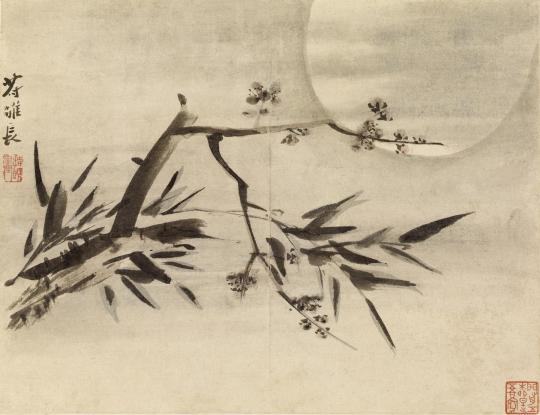
Gao Qipei (1660-1734), Bamboo Plum Blossoms and moon, 1713
9 notes
·
View notes
Photo

Tiger Seen from Above
by Gao Qipei (1660-1734),
c. 1700
Rijksmuseum, Amsterdam
7 notes
·
View notes
Photo
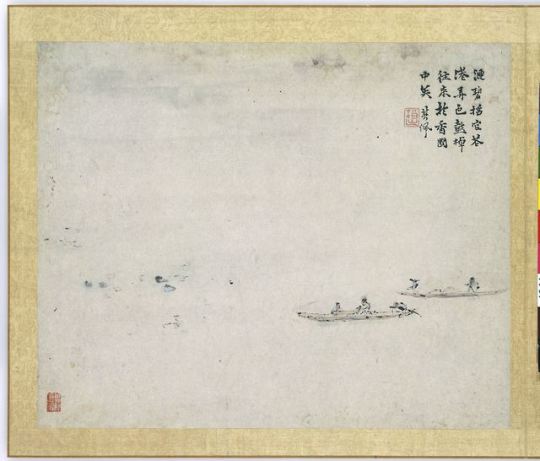
Silk painting with poem by 高其佩 Gao Qipei, China, 1700 - 1750
Rijksmuseum Amsterdam
Provenance: On loan from the Asian Art Society in The Netherlands (purchase Mayuyama Junkichi, Tokio, 1955)
AK-MAK-290-L
Gao Qipei (Chinese: 高其佩; pinyin: Gāo Qípeì; 1660–1734) was born in Jiangxi. He had success as an official in southern China, but is best known today as a painter. He initially gained reputation as an artist who did landscapes and figures in traditional style. By age twenty, he became known as an eccentric who preferred using his fingers instead of a brush. This style had precedents as Zhang Zao also preferred finger painting, but Gao Qipei went further. He grew his fingernails long to make them more effective instruments, and used his entire hand to create a highly individualized style.
[textsource: @wikipedia]
9 notes
·
View notes
Photo
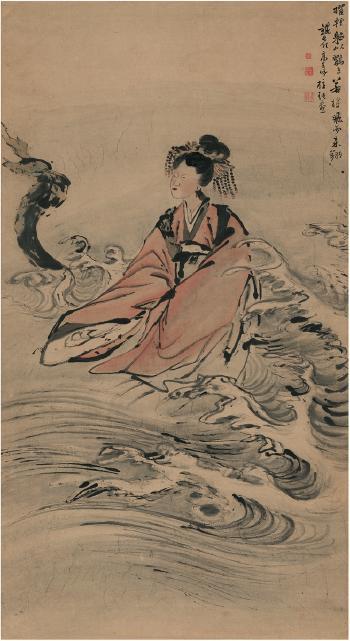
Fairy Luo by Gao Qipei (1660 - 1734)
98 notes
·
View notes
Photo

Veil, HyunJung Kim
Heaviness wrapped up with Lightness – Reading Kim HyunJung’s painting Lee DongChun (Fine art Connoisseur) Kim HyunJung’s paintings are cute and interesting. Her painting reminds us of paintings by Qi Baishi 齐白石 (1864-1957). Qi Baishi pursued beauty in his life, and his artistic spirit is found in his plant-and-insect paintings, flower-and-bird paintings, and figure paintings. Qi Baishi’s artistic spirit is sensed in Kim’s interesting subject matter and candid depiction.Kim audaciously uses ink and bright hues in in the manner of Qi Baishi who applied ink to leaves and red to flowers 墨叶红花. The composition in which subject matter is drawn to the edge of the paper is parallel to that of Qi Baishi’s flower-and-bird paintings and landscape painting of Li Keran’s 李可染 (1907-1989). Kim obviously learned from Qi Baishi. Qi Baishi said, “Learn from me you stand, copy from me you fall 学我者生, 似我者死.” Kim modeled herself after Qi’s artistic spirit rather than his painting style. Kim explored the artistic spirit in Qi Baishi’s painting, in which he emphasizes the meaning of painting and expresses his spirit, and reconstructed this in a realistic rendition. She calls this the “chulsa-ipgong 出写入工” technique. This is a melding of “xieyi 写意” painting (painting that underlines the painter’s spirit), “gongbi-hwa 工笔画” (painting done very carefully with the utmost care for details), and a new invention in tune with her emotion. Zheng Xie 郑燮 (1693-1765), one of the Eight Eccentrics of Yangzhou during the Qing Dynasty asserted, “Learn half, and throw away half 学一半, 撇一半.” This means even if a tradition is excellent, you have to learn only half of it. However, the traditional is currently completely disregarded. Kim learned her ‘half’ from traditional Eastern techniques. She studied the idioms of flower-and-bird painting from Song Dynasty, and learned from artists such as Chen HongShou 陈洪绶 (1599-1652), Yun ShouPing 恽寿平 (1633-1690), ShiTao 石涛 (1641-1707), BaDaShanRen 八大山人 (1625-1705), Gao QiPei 高其佩 (1660-1734), Jin Nong 金农 (1687-1764), and Kim HongDo 金弘道 (1745-1806). Moreover, she explored new methods in expression of color in traditional techniques. As she felt insufficiency in the use of pigment to depict significant parts of a painting, she made use of embroidery. This technique called “hwaju-subo 画主绣补” (Paining is used as primary and embroidery as ancillary) brought a new vitality to gongbi-hwa. The techniques of “chulsa-ipgong” and “hwaju-subo” are not the only revolution and innovation Kim has pursued. Getting psychological counselling, Kim realized the existence of her inner-child. She named her “Lala” and represented her special emotion in a pictorial language through this. Her Lala painting is a projection of her inner-child that she became aware of through psychological consultation, and for the artist a process of healing. This painting is in no way the product of pop art, but the sublimation of an artist’s inner-child to a work of art for the first time in art history. Kim’s Finding implicit rules is a portrayal of a young girl in meditation. The little girl carrying Lala on her back gazes vacantly at a dragonfly on a bare branch against the backdrop of a brick wall. Lala and the little girl look cute. The brick wall is a metaphor for constant time whereas the bare branches and dragonfly represent finite time in nature. The dragonfly acts out as the last leaf by O. Henry (William Sydney Porter, 1862-1910). As a projection of a psychological essay in painting, this work is a new literati painting of the 21st century reflecting Kim’s distinctive art-world. Kim lends new energy to gongbi-hwa through her realization of traditional Eastern painting. Kim has incarnated the spiritual world of intellectuals in our age in exquisite, flamboyant gongbi-hwa. This is why Chinese aestheticians and art historians have recently taken note of Kim’s painting.
https://www.saatchiart.com/art/Painting-Veil/960197/3943575/view
1 note
·
View note
Photo
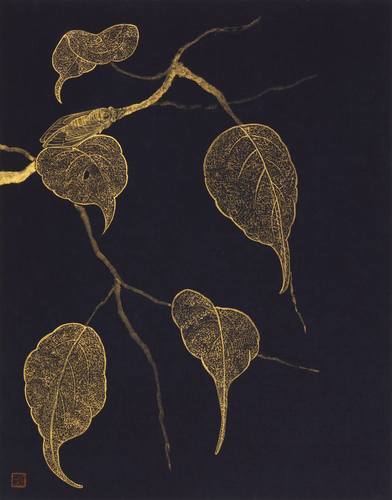
Prayer of A Cicada, HyunJung Kim
Drawing: goldpowder and realgold on Paper. Heaviness wrapped up with Lightness – Reading Kim HyunJung’s painting Lee DongChun (Fine art Connoisseur) Kim HyunJung’s paintings are cute and interesting. Her painting reminds us of paintings by Qi Baishi 齐白石 (1864-1957). Qi Baishi pursued beauty in his life, and his artistic spirit is found in his plant-and-insect paintings, flower-and-bird paintings, and figure paintings. Qi Baishi’s artistic spirit is sensed in Kim’s interesting subject matter and candid depiction.Kim audaciously uses ink and bright hues in in the manner of Qi Baishi who applied ink to leaves and red to flowers 墨叶红花. The composition in which subject matter is drawn to the edge of the paper is parallel to that of Qi Baishi’s flower-and-bird paintings and landscape painting of Li Keran’s 李可染 (1907-1989). Kim obviously learned from Qi Baishi. Qi Baishi said, “Learn from me you stand, copy from me you fall 学我者生, 似我者死.” Kim modeled herself after Qi’s artistic spirit rather than his painting style. Kim explored the artistic spirit in Qi Baishi’s painting, in which he emphasizes the meaning of painting and expresses his spirit, and reconstructed this in a realistic rendition. She calls this the “chulsa-ipgong 出写入工” technique. This is a melding of “xieyi 写意” painting (painting that underlines the painter’s spirit), “gongbi-hwa 工笔画” (painting done very carefully with the utmost care for details), and a new invention in tune with her emotion. Zheng Xie 郑燮 (1693-1765), one of the Eight Eccentrics of Yangzhou during the Qing Dynasty asserted, “Learn half, and throw away half 学一半, 撇一半.” This means even if a tradition is excellent, you have to learn only half of it. However, the traditional is currently completely disregarded. Kim learned her ‘half’ from traditional Eastern techniques. She studied the idioms of flower-and-bird painting from Song Dynasty, and learned from artists such as Chen HongShou 陈洪绶 (1599-1652), Yun ShouPing 恽寿平 (1633-1690), ShiTao 石涛 (1641-1707), BaDaShanRen 八大山人 (1625-1705), Gao QiPei 高其佩 (1660-1734), Jin Nong 金农 (1687-1764), and Kim HongDo 金弘道 (1745-1806). Moreover, she explored new methods in expression of color in traditional techniques. As she felt insufficiency in the use of pigment to depict significant parts of a painting, she made use of embroidery. This technique called “hwaju-subo 画主绣补” (Paining is used as primary and embroidery as ancillary) brought a new vitality to gongbi-hwa. The techniques of “chulsa-ipgong” and “hwaju-subo” are not the only revolution and innovation Kim has pursued. Getting psychological counselling, Kim realized the existence of her inner-child. She named her “Lala” and represented her special emotion in a pictorial language through this. Her Lala painting is a projection of her inner-child that she became aware of through psychological consultation, and for the artist a process of healing. This painting is in no way the product of pop art, but the sublimation of an artist’s inner-child to a work of art for the first time in art history. Kim’s Finding implicit rules is a portrayal of a young girl in meditation. The little girl carrying Lala on her back gazes vacantly at a dragonfly on a bare branch against the backdrop of a brick wall. Lala and the little girl look cute. The brick wall is a metaphor for constant time whereas the bare branches and dragonfly represent finite time in nature. The dragonfly acts out as the last leaf by O. Henry (William Sydney Porter, 1862-1910). As a projection of a psychological essay in painting, this work is a new literati painting of the 21st century reflecting Kim’s distinctive art-world. Kim lends new energy to gongbi-hwa through her realization of traditional Eastern painting. Kim has incarnated the spiritual world of intellectuals in our age in exquisite, flamboyant gongbi-hwa. This is why Chinese aestheticians and art historians have recently taken note of Kim’s painting.
https://www.saatchiart.com/art/Painting-Prayer-of-A-Cicada/960197/3943611/view
11 notes
·
View notes
Photo
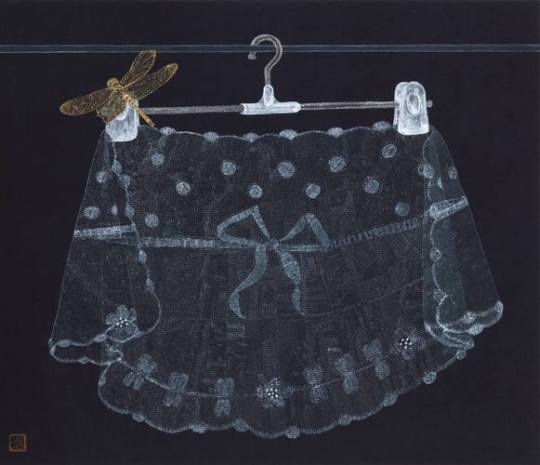
Veil, HyunJung Kim
Heaviness wrapped up with Lightness – Reading Kim HyunJung’s painting Lee DongChun (Fine art Connoisseur) Kim HyunJung’s paintings are cute and interesting. Her painting reminds us of paintings by Qi Baishi 齐白石 (1864-1957). Qi Baishi pursued beauty in his life, and his artistic spirit is found in his plant-and-insect paintings, flower-and-bird paintings, and figure paintings. Qi Baishi’s artistic spirit is sensed in Kim’s interesting subject matter and candid depiction.Kim audaciously uses ink and bright hues in in the manner of Qi Baishi who applied ink to leaves and red to flowers 墨叶红花. The composition in which subject matter is drawn to the edge of the paper is parallel to that of Qi Baishi’s flower-and-bird paintings and landscape painting of Li Keran’s 李可染 (1907-1989). Kim obviously learned from Qi Baishi. Qi Baishi said, “Learn from me you stand, copy from me you fall 学我者生, 似我者死.” Kim modeled herself after Qi’s artistic spirit rather than his painting style. Kim explored the artistic spirit in Qi Baishi’s painting, in which he emphasizes the meaning of painting and expresses his spirit, and reconstructed this in a realistic rendition. She calls this the “chulsa-ipgong 出写入工” technique. This is a melding of “xieyi 写意” painting (painting that underlines the painter’s spirit), “gongbi-hwa 工笔画” (painting done very carefully with the utmost care for details), and a new invention in tune with her emotion. Zheng Xie 郑燮 (1693-1765), one of the Eight Eccentrics of Yangzhou during the Qing Dynasty asserted, “Learn half, and throw away half 学一半, 撇一半.” This means even if a tradition is excellent, you have to learn only half of it. However, the traditional is currently completely disregarded. Kim learned her ‘half’ from traditional Eastern techniques. She studied the idioms of flower-and-bird painting from Song Dynasty, and learned from artists such as Chen HongShou 陈洪绶 (1599-1652), Yun ShouPing 恽寿平 (1633-1690), ShiTao 石涛 (1641-1707), BaDaShanRen 八大山人 (1625-1705), Gao QiPei 高其佩 (1660-1734), Jin Nong 金农 (1687-1764), and Kim HongDo 金弘道 (1745-1806). Moreover, she explored new methods in expression of color in traditional techniques. As she felt insufficiency in the use of pigment to depict significant parts of a painting, she made use of embroidery. This technique called “hwaju-subo 画主绣补” (Paining is used as primary and embroidery as ancillary) brought a new vitality to gongbi-hwa. The techniques of “chulsa-ipgong” and “hwaju-subo” are not the only revolution and innovation Kim has pursued. Getting psychological counselling, Kim realized the existence of her inner-child. She named her “Lala” and represented her special emotion in a pictorial language through this. Her Lala painting is a projection of her inner-child that she became aware of through psychological consultation, and for the artist a process of healing. This painting is in no way the product of pop art, but the sublimation of an artist’s inner-child to a work of art for the first time in art history. Kim’s Finding implicit rules is a portrayal of a young girl in meditation. The little girl carrying Lala on her back gazes vacantly at a dragonfly on a bare branch against the backdrop of a brick wall. Lala and the little girl look cute. The brick wall is a metaphor for constant time whereas the bare branches and dragonfly represent finite time in nature. The dragonfly acts out as the last leaf by O. Henry (William Sydney Porter, 1862-1910). As a projection of a psychological essay in painting, this work is a new literati painting of the 21st century reflecting Kim’s distinctive art-world. Kim lends new energy to gongbi-hwa through her realization of traditional Eastern painting. Kim has incarnated the spiritual world of intellectuals in our age in exquisite, flamboyant gongbi-hwa. This is why Chinese aestheticians and art historians have recently taken note of Kim’s painting.
https://www.saatchiart.com/art/Painting-Veil/960197/3943575/view
1 note
·
View note
Photo

Pryer of A Cicada / 貝葉蟬, HyunJung Kim
Heaviness wrapped up with Lightness – Reading Kim HyunJung’s painting Lee DongChun (Fine art Connoisseur) Kim HyunJung’s paintings are cute and interesting. Her painting reminds us of paintings by Qi Baishi 齐白石 (1864-1957). Qi Baishi pursued beauty in his life, and his artistic spirit is found in his plant-and-insect paintings, flower-and-bird paintings, and figure paintings. Qi Baishi’s artistic spirit is sensed in Kim’s interesting subject matter and candid depiction.Kim audaciously uses ink and bright hues in in the manner of Qi Baishi who applied ink to leaves and red to flowers 墨叶红花. The composition in which subject matter is drawn to the edge of the paper is parallel to that of Qi Baishi’s flower-and-bird paintings and landscape painting of Li Keran’s 李可染 (1907-1989). Kim obviously learned from Qi Baishi. Qi Baishi said, “Learn from me you stand, copy from me you fall 学我者生, 似我者死.” Kim modeled herself after Qi’s artistic spirit rather than his painting style. Kim explored the artistic spirit in Qi Baishi’s painting, in which he emphasizes the meaning of painting and expresses his spirit, and reconstructed this in a realistic rendition. She calls this the “chulsa-ipgong 出写入工” technique. This is a melding of “xieyi 写意” painting (painting that underlines the painter’s spirit), “gongbi-hwa 工笔画” (painting done very carefully with the utmost care for details), and a new invention in tune with her emotion. Zheng Xie 郑燮 (1693-1765), one of the Eight Eccentrics of Yangzhou during the Qing Dynasty asserted, “Learn half, and throw away half 学一半, 撇一半.” This means even if a tradition is excellent, you have to learn only half of it. However, the traditional is currently completely disregarded. Kim learned her ‘half’ from traditional Eastern techniques. She studied the idioms of flower-and-bird painting from Song Dynasty, and learned from artists such as Chen HongShou 陈洪绶 (1599-1652), Yun ShouPing 恽寿平 (1633-1690), ShiTao 石涛 (1641-1707), BaDaShanRen 八大山人 (1625-1705), Gao QiPei 高其佩 (1660-1734), Jin Nong 金农 (1687-1764), and Kim HongDo 金弘道 (1745-1806). Moreover, she explored new methods in expression of color in traditional techniques. As she felt insufficiency in the use of pigment to depict significant parts of a painting, she made use of embroidery. This technique called “hwaju-subo 画主绣补” (Paining is used as primary and embroidery as ancillary) brought a new vitality to gongbi-hwa. The techniques of “chulsa-ipgong” and “hwaju-subo” are not the only revolution and innovation Kim has pursued. Getting psychological counselling, Kim realized the existence of her inner-child. She named her “Lala” and represented her special emotion in a pictorial language through this. Her Lala painting is a projection of her inner-child that she became aware of through psychological consultation, and for the artist a process of healing. This painting is in no way the product of pop art, but the sublimation of an artist’s inner-child to a work of art for the first time in art history. Kim’s Finding implicit rules is a portrayal of a young girl in meditation. The little girl carrying Lala on her back gazes vacantly at a dragonfly on a bare branch against the backdrop of a brick wall. Lala and the little girl look cute. The brick wall is a metaphor for constant time whereas the bare branches and dragonfly represent finite time in nature. The dragonfly acts out as the last leaf by O. Henry (William Sydney Porter, 1862-1910). As a projection of a psychological essay in painting, this work is a new literati painting of the 21st century reflecting Kim’s distinctive art-world. Kim lends new energy to gongbi-hwa through her realization of traditional Eastern painting. Kim has incarnated the spiritual world of intellectuals in our age in exquisite, flamboyant gongbi-hwa. This is why Chinese aestheticians and art historians have recently taken note of Kim’s painting.
https://www.saatchiart.com/art/Drawing-Pryer-of-A-Cicada/960197/3514676/view
0 notes
Photo

Pryer of A Cicada / 貝葉蟬, HyunJung Kim
Heaviness wrapped up with Lightness – Reading Kim HyunJung’s painting Lee DongChun (Fine art Connoisseur) Kim HyunJung’s paintings are cute and interesting. Her painting reminds us of paintings by Qi Baishi 齐白石 (1864-1957). Qi Baishi pursued beauty in his life, and his artistic spirit is found in his plant-and-insect paintings, flower-and-bird paintings, and figure paintings. Qi Baishi’s artistic spirit is sensed in Kim’s interesting subject matter and candid depiction.Kim audaciously uses ink and bright hues in in the manner of Qi Baishi who applied ink to leaves and red to flowers 墨叶红花. The composition in which subject matter is drawn to the edge of the paper is parallel to that of Qi Baishi’s flower-and-bird paintings and landscape painting of Li Keran’s 李可染 (1907-1989). Kim obviously learned from Qi Baishi. Qi Baishi said, “Learn from me you stand, copy from me you fall 学我者生, 似我者死.” Kim modeled herself after Qi’s artistic spirit rather than his painting style. Kim explored the artistic spirit in Qi Baishi’s painting, in which he emphasizes the meaning of painting and expresses his spirit, and reconstructed this in a realistic rendition. She calls this the “chulsa-ipgong 出写入工” technique. This is a melding of “xieyi 写意” painting (painting that underlines the painter’s spirit), “gongbi-hwa 工笔画” (painting done very carefully with the utmost care for details), and a new invention in tune with her emotion. Zheng Xie 郑燮 (1693-1765), one of the Eight Eccentrics of Yangzhou during the Qing Dynasty asserted, “Learn half, and throw away half 学一半, 撇一半.” This means even if a tradition is excellent, you have to learn only half of it. However, the traditional is currently completely disregarded. Kim learned her ‘half’ from traditional Eastern techniques. She studied the idioms of flower-and-bird painting from Song Dynasty, and learned from artists such as Chen HongShou 陈洪绶 (1599-1652), Yun ShouPing 恽寿平 (1633-1690), ShiTao 石涛 (1641-1707), BaDaShanRen 八大山人 (1625-1705), Gao QiPei 高其佩 (1660-1734), Jin Nong 金农 (1687-1764), and Kim HongDo 金弘道 (1745-1806). Moreover, she explored new methods in expression of color in traditional techniques. As she felt insufficiency in the use of pigment to depict significant parts of a painting, she made use of embroidery. This technique called “hwaju-subo 画主绣补” (Paining is used as primary and embroidery as ancillary) brought a new vitality to gongbi-hwa. The techniques of “chulsa-ipgong” and “hwaju-subo” are not the only revolution and innovation Kim has pursued. Getting psychological counselling, Kim realized the existence of her inner-child. She named her “Lala” and represented her special emotion in a pictorial language through this. Her Lala painting is a projection of her inner-child that she became aware of through psychological consultation, and for the artist a process of healing. This painting is in no way the product of pop art, but the sublimation of an artist’s inner-child to a work of art for the first time in art history. Kim’s Finding implicit rules is a portrayal of a young girl in meditation. The little girl carrying Lala on her back gazes vacantly at a dragonfly on a bare branch against the backdrop of a brick wall. Lala and the little girl look cute. The brick wall is a metaphor for constant time whereas the bare branches and dragonfly represent finite time in nature. The dragonfly acts out as the last leaf by O. Henry (William Sydney Porter, 1862-1910). As a projection of a psychological essay in painting, this work is a new literati painting of the 21st century reflecting Kim’s distinctive art-world. Kim lends new energy to gongbi-hwa through her realization of traditional Eastern painting. Kim has incarnated the spiritual world of intellectuals in our age in exquisite, flamboyant gongbi-hwa. This is why Chinese aestheticians and art historians have recently taken note of Kim’s painting.
https://www.saatchiart.com/art/Drawing-Pryer-of-A-Cicada/960197/3514676/view
0 notes
Photo

Pryer of A Cicada / 貝葉蟬, HyunJung Kim
Heaviness wrapped up with Lightness – Reading Kim HyunJung’s painting Lee DongChun (Fine art Connoisseur) Kim HyunJung’s paintings are cute and interesting. Her painting reminds us of paintings by Qi Baishi 齐白石 (1864-1957). Qi Baishi pursued beauty in his life, and his artistic spirit is found in his plant-and-insect paintings, flower-and-bird paintings, and figure paintings. Qi Baishi’s artistic spirit is sensed in Kim’s interesting subject matter and candid depiction.Kim audaciously uses ink and bright hues in in the manner of Qi Baishi who applied ink to leaves and red to flowers 墨叶红花. The composition in which subject matter is drawn to the edge of the paper is parallel to that of Qi Baishi’s flower-and-bird paintings and landscape painting of Li Keran’s 李可染 (1907-1989). Kim obviously learned from Qi Baishi. Qi Baishi said, “Learn from me you stand, copy from me you fall 学我者生, 似我者死.” Kim modeled herself after Qi’s artistic spirit rather than his painting style. Kim explored the artistic spirit in Qi Baishi’s painting, in which he emphasizes the meaning of painting and expresses his spirit, and reconstructed this in a realistic rendition. She calls this the “chulsa-ipgong 出写入工” technique. This is a melding of “xieyi 写意” painting (painting that underlines the painter’s spirit), “gongbi-hwa 工笔画” (painting done very carefully with the utmost care for details), and a new invention in tune with her emotion. Zheng Xie 郑燮 (1693-1765), one of the Eight Eccentrics of Yangzhou during the Qing Dynasty asserted, “Learn half, and throw away half 学一半, 撇一半.” This means even if a tradition is excellent, you have to learn only half of it. However, the traditional is currently completely disregarded. Kim learned her ‘half’ from traditional Eastern techniques. She studied the idioms of flower-and-bird painting from Song Dynasty, and learned from artists such as Chen HongShou 陈洪绶 (1599-1652), Yun ShouPing 恽寿平 (1633-1690), ShiTao 石涛 (1641-1707), BaDaShanRen 八大山人 (1625-1705), Gao QiPei 高其佩 (1660-1734), Jin Nong 金农 (1687-1764), and Kim HongDo 金弘道 (1745-1806). Moreover, she explored new methods in expression of color in traditional techniques. As she felt insufficiency in the use of pigment to depict significant parts of a painting, she made use of embroidery. This technique called “hwaju-subo 画主绣补” (Paining is used as primary and embroidery as ancillary) brought a new vitality to gongbi-hwa. The techniques of “chulsa-ipgong” and “hwaju-subo” are not the only revolution and innovation Kim has pursued. Getting psychological counselling, Kim realized the existence of her inner-child. She named her “Lala” and represented her special emotion in a pictorial language through this. Her Lala painting is a projection of her inner-child that she became aware of through psychological consultation, and for the artist a process of healing. This painting is in no way the product of pop art, but the sublimation of an artist’s inner-child to a work of art for the first time in art history. Kim’s Finding implicit rules is a portrayal of a young girl in meditation. The little girl carrying Lala on her back gazes vacantly at a dragonfly on a bare branch against the backdrop of a brick wall. Lala and the little girl look cute. The brick wall is a metaphor for constant time whereas the bare branches and dragonfly represent finite time in nature. The dragonfly acts out as the last leaf by O. Henry (William Sydney Porter, 1862-1910). As a projection of a psychological essay in painting, this work is a new literati painting of the 21st century reflecting Kim’s distinctive art-world. Kim lends new energy to gongbi-hwa through her realization of traditional Eastern painting. Kim has incarnated the spiritual world of intellectuals in our age in exquisite, flamboyant gongbi-hwa. This is why Chinese aestheticians and art historians have recently taken note of Kim’s painting.
https://www.saatchiart.com/art/Drawing-Pryer-of-A-Cicada/960197/3514676/view
0 notes